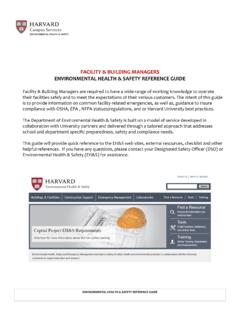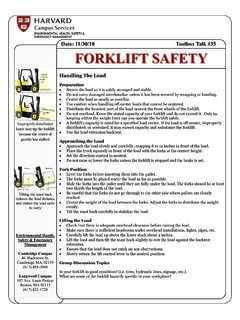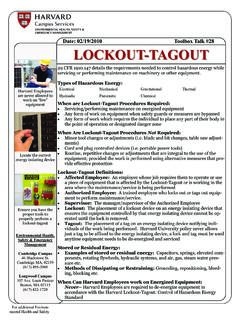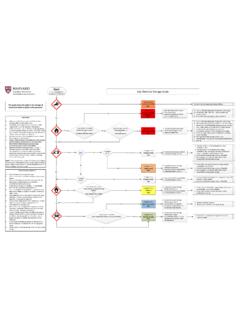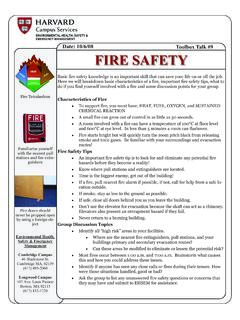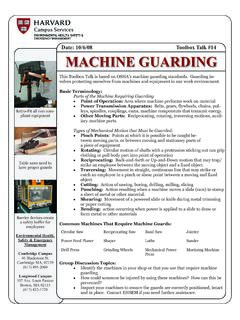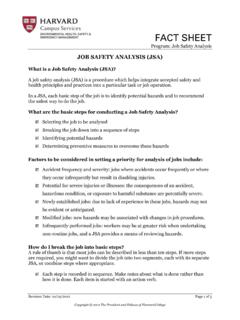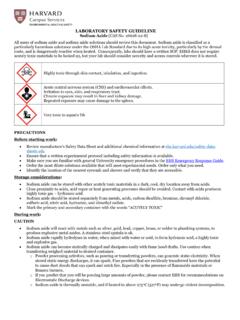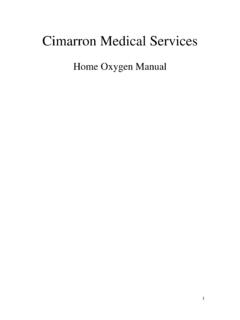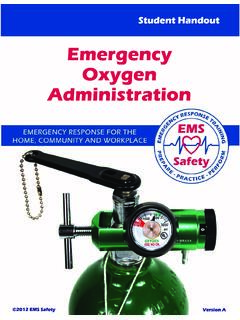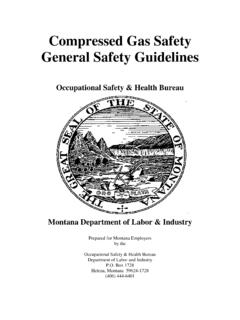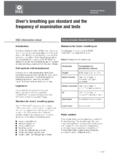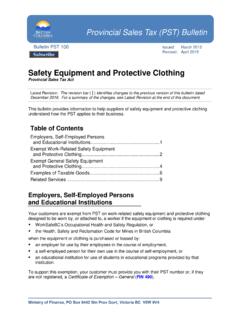Transcription of Oxygen Storage - Harvard University
1 FACT SHEET Program: Lab Fire Safety Revision Date: 04/03/2015 Page 1 of 3 Copyright 2015 The President and Fellows of Harvard College Oxygen Storage Introduction Oxygen is a colorless, odorless and tasteless gas. Although nonflammable, Oxygen readily supports combustion. Oxygen vigorously accelerates combustion - some materials which are noncombustible in air will burn in the presence of an Oxygen enriched atmosphere (greater than 23%). Hazards As a non-liquid gas it is shipped at pressures of 2000 psig or above. Pure Oxygen , at high pressure can react violently with common materials such as oil and grease and other hydrocarbon materials. All materials connected to a cylinder of Oxygen must be compatible and designed specifically for Oxygen use.
2 Inhalation of 100% Oxygen can cause nausea, dizziness, irritation of lungs, pulmonary edema, pneumonia, and collapse. Liquid Oxygen is cryogenic and is capable of causing severe tissue damage upon exposure. Storage & Handling The Massachusetts Comprehensive Fire Safety Code (527 CMR 1) regulates the Storage and use of hazardous materials posing a physical hazard and limits the maximum allowable quantity (MAQ) per control area. Oxygen in the gaseous state is limited to 1,500 cubic feet; the maximum allowable quantities (MAQ) can be increased 100% in buildings equipped throughout with an automatic sprinkler system. However, t here are reductions/prohibitions to Storage and use of Oxygen based on specific location within the building.
3 (527 CMR 1) Never allow oil, greases and other readily combustible substances to come in contact with Oxygen cylinders, valves, regulators , and fittings. Store gas cylinders in a ventilated and well-lit area away from combustible materials. Separate specialty gases by type and store in assigned locations that can be readily identified. (Compressed Gas Association, Inc. CGA P-1 -2000) Compressed Gases Can Present Significant Safety Hazards Store Oxygen cylinders away from heavily trafficked areas and emergency exits. (Air Products Safetygram #1 Gaseous Oxygen ). Do not store near elevators, corridors or loading docks. Cylinders should also be stored where they can be protected from tampering by unauthorized personnel.
4 Do not allow area where cylinders are stored to exceed 52 C (125 F). Post No Smoking in Storage and in use areas. FACT SHEET Program: Lab Fire Safety Revision Date: 04/03/2015 Page 2 of 3 Copyright 2015 The President and Fellows of Harvard College 0 02 0 OX Protect Cylinders Against Physical Damage Store in cool, dry, well-ventilated, fireproof area, away from flammable materials and corrosive atmospheres. Store away from heat and ignition sources and out of direct sunlight. Cylinders should be stored upright and be firmly secured to prevent falling or being knocked over. Oxygen cylinders in Storage shall be separated from fuel-gas cylinders or combustible materials (especially oil or grease), a minimum distance of 20 feet ( m) or by a noncombustible barrier at least 5 feet ( m) high having a fire-resistance rating of at least one-half hour.
5 (OSHA, NFPA) Precaution to Take When Handling Never permit oil, grease, or other combustible substances to come into contact with Oxygen or other oxidizing gas cylinders, valves, and systems. (Compressed Gas Association, Inc. CGA P-1 -2000) Oxygen cylinders or apparatus shall not be handled with oily hands or gloves (OSHA). Use a cylinder cart to safely transport cylinders, do not roll. Disposal Oxygen cylinders should be returned to the compressed gas distributor when emptied or no longer used. Safety Data Sheet Link: Gas FACT SHEET Program: Lab Fire Safety Revision Date: 04/03/2015 Page 3 of 3 Copyright 2015 The President and Fellows of Harvard College References: Compressed Gas Association, Inc.
6 CGA P-1 -2000 Occupational Health & Safety Administration (OSHA) 29 CFR , NFPA 101 - Life Safety Code, (NFPA -101), National Fire Protection Association Massachusetts State Building Code, 780 CMR Chapter 3 and Chapter 4 Massachusetts Comprehensive Fire Safety Code, NFPA 1 - 2012 edition as modified by 527 CMR Massachusetts General Laws - Chapters 148 Fire Prevention The Cambridge Fire Department (CFD) or local fire department is the authority having jurisdiction (AHJ) and can be more restrictive and require additional safety precautions/requirements under Massachusetts General Laws ( )
